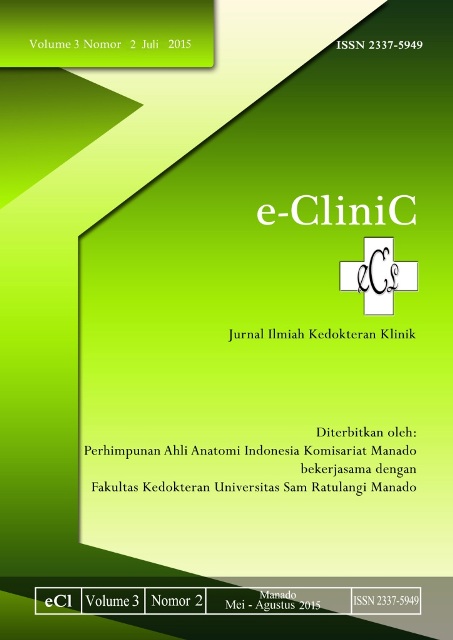POLA LUKA PADA KEMATIAN AKIBAT KEKERASAN TAJAM DI BAGIAN ILMU KEDOKTERAN FORENSIK DAN MEDIKOLEGAL RSUP PROF. DR. R. D. KANDOU MANADO PERIODE 2013
DOI:
https://doi.org/10.35790/ecl.v3i2.8383Abstract
Abstract: Wounds caused by a sharp trauma is an injury caused by sharp or pointed edged instruments. There are three types of wounds: stabbed, sliced, and chopped. This study aimed to determine the pattern of injuries in dead cases due to sharp trauma at the Department of Forensic Medicine and Medicolegal Prof. Dr. R. D. Kandou Hospital Manado. This was a descriptive retrospective study using the results of visum et repertum. The results showed that the percentages of wounds leading to the death were: 89% stabbed wounds, 5% sliced wounds, and 6% chopped wounds. Most victims were at the age group of 20-30 years, followed by the age group of 30-40 years, 40-50 years, and 50-60 years.
Keywords: wound patterns, sharp violence
Abstrak: Luka akibat kekerasan tajam adalah kelainan pada tubuh yang disebabkan karena tertusuk atau tergores dengan benda atau alat yang bermata tajam atau berujung runcing. Luka akibat kekerasan tajam terbagi atas tiga, yakni luka tusuk, luka iris dan luka bacok. Penelitian ini bertujuan untuk mengetahui pola luka pada kematian akibat kekerasan tajam di Bagian Ilmu Kedokteran Forensik dan Medikolegal RSUP. Prof. Dr. R. D. Kandou Manado. Penelitian ini bersifat deskriptif retrospektif dengan mengambil data sekunder dari hasil visum et repertum. Dari hasil penelitian dapat diperoleh persentase luka yang menyebabkan kematian yakni: luka tusuk 89%, luka iris 5%, dan luka bacok 6%. Distribusi umur korban kematian umumnya dari kalangan muda 20-30 tahun, diikuti oleh kelompok umur 30-40 tahun, umur 40-50 tahun, dan umur 50-60 tahun.
Kata kunci: pola luka, kekerasan tajam
Downloads
How to Cite
Issue
Section
License
COPYRIGHT
Authors who publish with this journal agree to the following terms:
Authors hold their copyright and grant this journal the privilege of first publication, with the work simultaneously licensed under a Creative Commons Attribution License that permits others to impart the work with an acknowledgment of the work's origin and initial publication by this journal.
Authors can enter into separate or additional contractual arrangements for the non-exclusive distribution of the journal's published version of the work (for example, post it to an institutional repository or publish it in a book), with an acknowledgment of its underlying publication in this journal.
Authors are permitted and encouraged to post their work online (for example, in institutional repositories or on their website) as it can lead to productive exchanges, as well as earlier and greater citation of the published work (See The Effect of Open Access).







